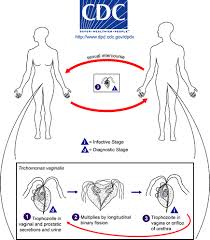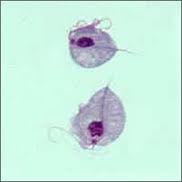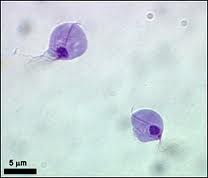|
Trichomonas:
It is a parasite. 10-30 micrometer which is responsible for one of the most widespread STDs worldwide. It is a microscopic and not visible with eye.Trichomonaisis is sexually transmitted disease induce by Trichomonas. It is very common among female patients ,however, it could live in urethra of male genital and cause symptom or be completely symptomatic. We have seen many patients that having partner with positive Trichomonas test result and they wonder if they are source of the infection or not or if they need to get treatment. We answer all your questions and your concern during your visit.
Trichomonas and STD:
Trichomonas is sexually transmitted disease. It means that it gets transmitted by sex, so obviously more common with female with multiple sexual partners or with male with multiple sexual partners.
If you are monogamous but your partner has multiple partners then you are at high risk as well.
If you get diagnosed with Trichomonas it is recommended that you get evaluated for other STDs to make sure that you have not been exposed.
Diagnosis:
Testing for trichomanos could be challenging as many tests might not be sensitive enough or has limitation for diagnostic in male patient. There has been indirect testing such as antigen for Trichomonas however in real clinical practice we had many patients with false negative or inaccurate result. Trichomonas must be diagnosed by experienced physician by direct analysis. The most important obstacle is in order to do direct microscopic study then the physician has to have laboratory licensing. In the past any physician could do microscopic study in office ,however, with new CLIA regulations and restriction then it is not that easy ,so doctors unable to do microscopic study unless they have special permission. CLIA was established to increase quality and accuracy of laboratory in United States.
Treatment:
Trichomonas gets treated by anti-parasit. It will be recomended to abstain from sex for certain period of time. We are able to treat you on same day of your visit. We are able to give you same day test result and same day treatment.
Trichomonas Prevention
Follow these guidelines.
- Abstain from sexual intercourse; or,
- Use a latex condom properly, every time you have sexual intercourse, with every partner.
- Limit your sexual partners. The more sex partners you have, the greater your risk of encountering someone who has this or other STDs.
- If you are infected, your sexual partner(s) should be treated. This will prevent you from getting re infected.

Symptom in Female:
Itching
Vaginal discharge
abdominal pain
Vaginal odor
etc
or no symptom at all
Symptom in Male:
Urethral discharge
urethral itching
burning
odor
pain on epidydimis
etc
or no symptom at all
  
Bacterial Vaginosis , Fungal, Parasite Testing &
Evaluations Today
Bacterial Vaginosis is
common infection in patient with multiple
sexual partners, so the
presence of STDs must always be considered. We
commonly see patients in our clinic who
complain of vaginal discomfort and
have been using intra vaginal cream
and medicine without effect. They
mostly get self treated for a
yeast infection which does not
effect the bacteria. We also see many
patients complaining of recurring symptoms.
A Doctor must obtain a complete patient history, perform a physical exam, and obtain appropriate samples for testing.
We
evaluate test and treat patients with bacterial
vaginosis with a high success rate. This
success is based on the fact that we
always do a complete work up and we
pay close attention to the sexual
partners role in symptomatic patients.
We always consider treating both
partners. Multi factorial possibilities for
BV make it challenging to
treat. For example, if you have trichomonas
then it does not mean that you do
not have other bacteria! If you
just get treated for trichomonas you
may feel better but not 100% and you may
still have symptoms if you have
a co infection with other organisms.
Not much
is known as to how women get BV, however,
we do know that those who have never
had sexual intercourse are rarely
affected. So important question is
that if it is a STD? Could your boyfriend
could give you BV if his ex was infected?
If partner needs to get treated if
he does not have any symptom? Further
studies and research may be needed
to answer similar questions.
We do know that you do not get BV from bedding, toilet seats, swimming pools, or from touching objects. It is still not clear what role sexual activity plays in the development of BV.
Symptoms of BV (could be one or more of following)
Vaginal discharge
Odor
Itching
Burning during urination
Vaginal tingling
Or according to CDC “no symptoms at all”
Testing and Diagnosis (learn what makes us really different)
The gold standard testing for Bacterial Vaginosis is direct Microscopic study (Gram Stain / wet mount). Cultures or Pap smears which are routinely performed are not a truly effective diagnostic test for BV. Please refer to CDC guidelines for further information. Direct microscopic study requires special laboratory licensing, quality control, proficient testing, and above all expertise. As a result, not many physicians or clinics are able to perform direct microscopy such as gram stain and they are limited to other methods. We have a variety of options in our center to choose from when it comes to Bacterial Vaginosis evaluations including gold standard microscopic testing.
Complications of BV if Left Untreated
1 - Pelvic Inflammatory Disease with ultimate infertility
2 - Susceptibility to HIV infection
3 - Susceptibility to other STDs, such as Gonorrhea & Chlamydia
Prevention of BV
Be abstinent.
Limit the number of partners.
Do not douche.
Use all of the medicine prescribed for treatment of BV, although the signs and symptoms may have gone away.
Treatment
BV is the effect and not the cause. Effective treatment depends on diagnosis, diagnosis and diagnosis. Not every patient is the same. The right antibiotic and treatment duration with possible life style changes could possibly be recommended by a doctor after the cause is uncovered.
For your convenience we have extended our phone lines
(323) 231-6000
(323) 231-7500
(323) 231-8200
(323) 231-7400
Welcome Walk-in
( Free Parking in Rear)
4524 S San Pedro Place
Los Angeles, CA 90011
|



































